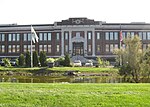Lincoln Highway Passaic River Bridge
1939 establishments in New JerseyBridges completed in 1939Bridges in Hudson County, New JerseyBridges in Newark, New JerseyBridges of the United States Numbered Highway System ... and 8 more
East Coast GreenwayKearny, New JerseyLincoln HighwayRoad bridges in New JerseySteel bridges in the United StatesU.S. Route 1U.S. Route 9Vertical lift bridges in New Jersey

The Lincoln Highway Passaic River Bridge is a vehicular moveable bridge crossing the Passaic River at a point 1.8 mi (2.9 km) from the river mouth at Newark Bay in northeastern New Jersey, United States. The vertical lift bridge, along the route of the Lincoln Highway, carries U.S. Route 1/9 Truck (at milepoint 0.67) and the East Coast Greenway between the Ironbound section of Newark and Kearny Point in Kearny. Opened in 1941, it is owned by and operated by the New Jersey Department of Transportation (NJDOT) and required by the Code of Federal Regulations to open on 4-hour notice for maritime traffic.
Excerpt from the Wikipedia article Lincoln Highway Passaic River Bridge (License: CC BY-SA 3.0, Authors, Images).Lincoln Highway Passaic River Bridge
Lincoln Highway,
Geographical coordinates (GPS) Address External links Nearby Places Show on map
Geographical coordinates (GPS)
| Latitude | Longitude |
|---|---|
| N 40.7324 ° | E -74.118 ° |
Address
Lincoln Highway
Lincoln Highway
07105
New Jersey, United States
Open on Google Maps






